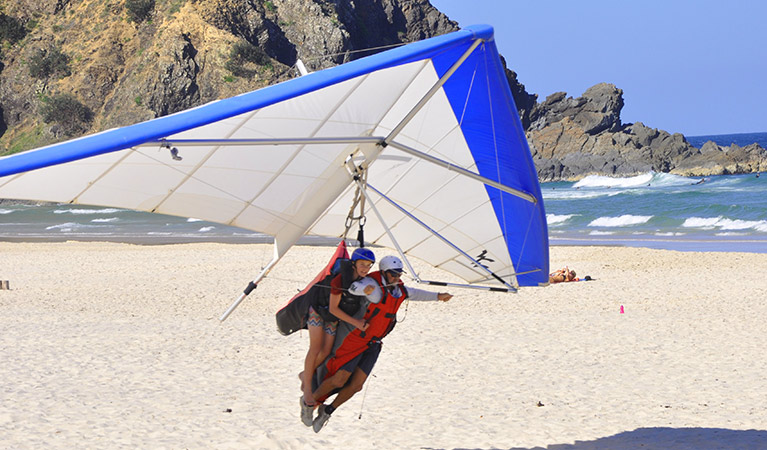Overview
Join Pro Flyte’s expert instructor for the tandem flight of your life and soar over stunning Walgun Cape Byron. It’s a great way to experience the excitement of hang gliding and take in fabulous coastal views.
- When
- Contact Pro Flyte for dates and times.
- Where
- Arakwal National Park in North Coast
- Accessibility
- No wheelchair access
- Grade
- Medium
- Price
- Contact Pro Flyte for pricing.
- Bookings
- Bookings required. Book online or email or call Pro Flyte on 0427 257 699.
You don’t need any experience for these fabulous flights. Your enthusiastic guide, former Australian champion Peter Aitken, has all the knowledge and skills needed to take you on the dream glide of a lifetime.
Soon you’ll be soaring like a bird over Walgun Cape Byron and nearby Arakwal National Park. It’s a great chance to photograph stunning views. Keep an eye out for dolphins and sharks swimming silently below, and remember to look for whales during their migration season. If this first taste of the freedom of flight has you keen for more, Pro Flyte has lessons to help you make the next step.
Pro Flyte is a licensed commercial tour operator with a Parks Eco Pass.
Local alerts
For the latest updates on fires, closures and other alerts in this area, see https://www.nationalparks.nsw.gov.au/things-to-do/guided-tours/tandem-hang-gliding-in-byron-bay-with-pro-flyte/local-alerts
Operated by

Park info
- in Arakwal National Park in the North Coast region
Arakwal National Park is always open but may be closed at times due to storm weather or fire danger.
Visitor info
All the practical information you need to know about Tandem hang gliding in Byron Bay with Pro Flyte.
Getting there and parking
Get driving directions
Contact Pro Flyte for directions.
Parking
Contact Pro Flyte for information on parking.
Maps and downloads
Accessibility
Disability access level - no wheelchair access
Learn more
Tandem hang gliding in Byron Bay with Pro Flyte is in Arakwal National Park. Here are just some of the reasons why this park is special:
Animals on the move

Arakwal may be small from the outside, but its borders hold some important habitat for threatened plant species like the creatively-named stinking crypotocarya, and dark greenhood. Keen nature enthusiasts will find much of interest; bring the magnifying glass, but be careful not to damage what you see. The reserve is also a temporary home to a range of nomadic and migratory animals, which means it's never quite the same in any given season. During autumn and winter, for example, the growing, flowering and fruiting season attracts birds, flying foxes and micro bats. Then there are the humpback whales, drifting past out to sea as they cycle annually between Queensland and the freezing waters of the Antarctic.
This is Aboriginal land

The reserve falls within the custodial boundaries of Bundjalung nation, with prime importance for the local Arakwal People who lend their name to the national park. The Bundjalung of Byron Bay (Arakwal) Peoples' connection to the reserve was recognised in 2001, with the signing of an Indigenous Land Use Agreement between the Bundjalung of Byron Bay (Arakwal) People and the NSW State Government.
Plants and animals protected in this park
Animals
-

White-bellied sea eagle (Haliaeetus leucogaster)
White-bellied sea eagles can be easily identified by their white tail and dark grey wings. These raptors are often spotted cruising the coastal breezes throughout Australia, and make for some scenic bird watching. Powerful Australian birds of prey, they are known to mate for life, and return each year to the same nest to breed.
-

Superb fairy wren (Malurus cyaneus)
The striking blue and black plumage of the adult male superb fairy wren makes for colourful bird watching across south-eastern Australia. The sociable superb fairy wrens, or blue wrens, are Australian birds living in groups consisting of a dominant male, mouse-brown female ‘jenny wrens’ and several tawny-brown juveniles.
-

Koala (Phascolarctos cinereus)
One of the most renowned Australian animals, the tree-dwelling marsupial koala can be found in gum tree forests and woodlands across eastern NSW, Victoria and Queensland, as well as in isolated regions in South Australia. With a vice-like grip, this perhaps most iconic but endangered Australian animal lives in tall eucalypts within a home range of several hectares.
-

Humpback whale (Megaptera novaeangliae)
The humpback whale has the longest migratory path of any mammal, travelling over 5000km from its summer feeding grounds in Antarctica to its breeding grounds in the subtropics. Its playful antics, such as body-rolling, breaching and pectoral slapping, are a spectacular sight for whale watchers in NSW national parks.

